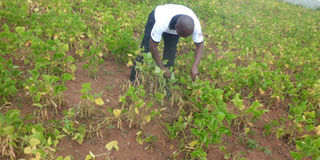Beans, quick to cook, easy to eat

Iron- and zinc-rich beans being tested at a field trial. PHOTO BY LOMINDA AFEDRARU
What you need to know:
- Beans are a popular addition to the diet but they take long to cook.
- To overcome this challenge, a number of innovations are afoot, writes Lominda Afedraru
Beans are a widely grown crop in Uganda and a key source of protein in many diets. Though they are mostly cooked, innovative ways of preparation are being explored in research and development.
One of these is as bean flour, which can be mixed with wheat to make confectionaries or mixed with millet flour to make porridge. Some process it as snacks and bean fingers, which are packaged as ready-to-eat meals.
Accordingly, scientists at National Crops Resources Research Institute(NaCRRI), in collaboration with their counterparts in Kenya, are undertaking a project in this regard. They have bred bean varieties containing iron and zinc, which will be processed as pre-cooked beans and sold in open markets in East Africa.
“Unprocessed dry beans, a traditional subsistence crop in East Africa are popular and nutritious but slow cooking food. In recent years, the rapid expansion of urban populations, rising incomes, and high costs of energy have fuelled the demand for fast cooking, processed foods,” said Dr Michael Ugen, the director of National Semi-Arid Resources Research Institute (NaSARRI), where pulse breeding is a key activity.
He was speaking at a recent event to mark the International Year of Pulses, which was declared by the United Nations, as 2016.
He added, “Canned or frozen beans are sometimes available, but are only affordable to a minority. Developing affordable bean products is therefore increasingly important.”
Therefore, pre-cooked beans and similar innovations will lead to improving food security, raise farmer incomes and conserve the environment in terms of saving energy.
Developing a viable pre-cooked bean industry requires reliable production of the appropriate beans, effective marketing, and competitive products.
This year, NaCRRI released five iron- and zinc-rich varieties: NAROBEAN 1, 2 and 3—which are bush beans—and 4C and 5C—which are climbing beans.
These are being grown by farmers mainly in Masaka who have been identfied as key suppliers for the factory that will process precooked beans.
Since there is ready market, a seed company in Rakai has organised farmers to grow the required quantity.
“Pulses are not only human food but used as feed for livestock. Adding value to pulses helps farmers increase their incomes,” noted Alhaji Jallow, FAO country representative.
While the NaCRRI director, Dr Geoffrey Asea, pointed out that pulse products help in solving issues of malnutrition due to the nutrient content; mainly protein, zinc and iron, which are important for the human body.
How it works
Some cook wet beans, which are later dried for processing but the incoming innovation will enable the beans to be pre-processed and cooked under high temperature and pressure.
The result will be dry processed pre-cooked beans as the technology enables cooking of the beans while at the same time drying them.
It will be packaged in airtight weather-proof aluminum sachets that can preserve the product for more than six months.
The product can also be packed in plastic containers or bags of varying sizes and be stored for more than a year.
Two private-sector partners—one in Uganda and the other in Kenya—have developed prototype products and are packaging them for market testing.
In Kenya, the product is already on the open market and for the case of Uganda, they will be readily available by early next year.
So far, two bean products are available in the Kenyan market, the salted ready-to-eat snack and the pre-cooked, packaged beans for reheating.




